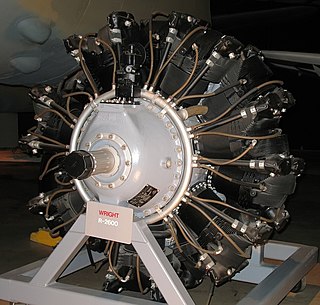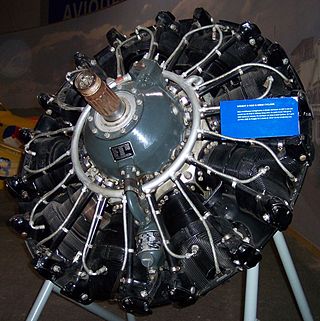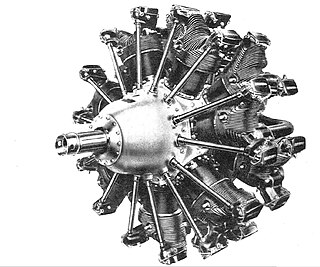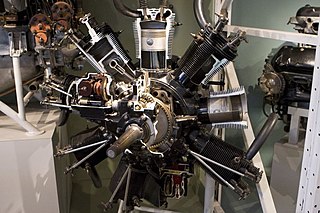
The Douglas DC-3 is a propeller-driven airliner manufactured by Douglas Aircraft Company, which had a lasting effect on the airline industry in the 1930s to 1940s and World War II. It was developed as a larger, improved 14-bed sleeper version of the Douglas DC-2. It is a low-wing metal monoplane with conventional landing gear, powered by two radial piston engines of 1,000–1,200 hp (750–890 kW). Although the DC-3s originally built for civil service had the Wright R-1820 Cyclone, later civilian DC-3s used the Pratt & Whitney R-1830 Twin Wasp engine. The DC-3 has a cruising speed of 207 mph (333 km/h), a capacity of 21 to 32 passengers or 6,000 lbs (2,700 kg) of cargo, and a range of 1,500 mi (2,400 km), and can operate from short runways.

The Wright R-3350 Duplex-Cyclone is an American twin-row, supercharged, air-cooled, radial aircraft engine with 18 cylinders displacing nearly 3,350 cubic inches (54.9 L). Power ranged from 2,200 to over 3,700 hp, depending on the model. Developed before World War II, the R-3350's design required a long time to mature before finally being used to power the Boeing B-29 Superfortress.

The Hispano-Suiza 12Y was an aircraft engine produced by Hispano-Suiza for the French Air Force before the Second World War. The 12Y became the primary French 1,000 hp (750 kW) class engine and was used in a number of famous aircraft, including the Morane-Saulnier M.S.406 and Dewoitine D.520.

The Pratt & Whitney R-2800 Double Wasp is an American twin-row, 18-cylinder, air-cooled radial aircraft engine with a displacement of 2,800 cu in (46 L), and is part of the long-lived Wasp family of engines.

The Wright R-2600 Cyclone 14 is an American radial engine developed by Curtiss-Wright and widely used in aircraft in the 1930s and 1940s.

Wright Cyclone was the name given to a family of air-cooled radial piston engines designed by the Wright Aeronautical Corporation and used in numerous American aircraft in the 1930s and 1940s.

The Pratt & Whitney R-1830 Twin Wasp is an American air-cooled radial aircraft engine. It displaces 1,830 cu in (30.0 L) and its bore and stroke are both 5.5 in (140 mm). The design traces its history to 1929 experiments at Pratt & Whitney on twin-row designs. Production began in 1932 and it was widely used during the 1930s.

The Klimov M-105 was a V12 liquid-cooled piston aircraft engine used by Soviet aircraft during World War II.

The Mikulin AM-34 (M-34) was a Soviet mass-produced, liquid-cooled, aircraft engine of domestic design. Its initial development was troubled, but it eventually became one of the most successful Soviet aircraft engines of the 1930s. It was utilized on numerous aircraft, including the Beriev MBR-2, Tupolev TB-3, Tupolev TB-4, Tupolev ANT-20, Petlyakov Pe-8, Kalinin K-7, Polikarpov I-17, and Bolkhovitinov DB-A, as well as the G-5 and various prototype motor torpedo boats. A version of the maritime model was adapted for use in several prototype heavy tanks in 1939, although none was placed into production.

The Wright R-1300 Cyclone 7 is an American air-cooled seven-cylinder supercharged radial aircraft engine produced by Curtiss-Wright.

The Wright R-975 Whirlwind was a series of nine-cylinder air-cooled radial aircraft engines built by the Wright Aeronautical division of Curtiss-Wright. These engines had a displacement of about 975 cu in (15.98 L) and power ratings of 300–450 hp (220–340 kW). They were the largest members of the Wright Whirlwind engine family to be produced commercially, and they were also the most numerous.
The Mitsubishi Kinsei was a 14-cylinder, air-cooled, twin-row radial aircraft engine developed by Mitsubishi Heavy Industries in Japan in 1934 for the Imperial Japanese Navy. The Mitsubishi model designation for this engine was A8 while it was an experimental project; in service, it was known as the MK8 "Kinsei" by the Navy. In 1941 the engine was adopted by Army, receiving designation Ha-112. In May 1943 it received Ha-33 unified designation code.

The Shvetsov M-25 was an aircraft radial engine produced in the Soviet Union (USSR) in the 1930s and 1940s, a licensed production variant of the Wright R-1820-F3.

The Hispano-Suiza 14AA, also known as Type 79, was a fourteen-cylinder aircraft radial engine used in France during the late 1930s. As Hispano-Suiza lacked recent experience in developing radial engines, it was derived from the licensed Wright R-2600 engine. Due to reliability problems, the engine was largely supplanted by the similar Gnome-Rhône 14N.

The Wright R-540 Whirlwind was a series of five-cylinder air-cooled radial aircraft engines built by the Wright Aeronautical division of Curtiss-Wright. These engines had a displacement of 540 in³ (8.85 L) and power ratings of around 165-175 hp (123-130 kW). They were the smallest members of the Wright Whirlwind engine family.

The Wright Whirlwind was a family of air-cooled radial aircraft engines built by Wright Aeronautical. The family began with nine-cylinder engines, and later expanded to include five-cylinder and seven-cylinder varieties. Fourteen-cylinder twin-row versions were also developed, but these were not commercially produced.
The Shvetsov M-71 was a Soviet radial engine built in small numbers during World War II. It was derived from the Shvetsov M-25, which was a license-built copy of the American Wright R-1820-F3 Cyclone engine.


















